
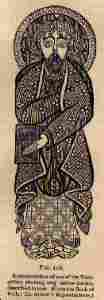
Woollen and linen clothes formed the dress of the great mass of the people. Both were produced at home; and elsewhere in this book the mode of manufacturing them will be described. Silk and satin, which were of course imported, were much worn among the higher classes, and we find both constantly noticed in our literature. The flags and banners used with armies were usually made of silk or satin. The ordinary word for silk was sida [sheeda]; and for satin, sról [srole]. The furs of animals, such as seals, otters, badgers, foxes, &c., were much used for capes and jackets, and for the edgings or various garments, so that skins of all the various kinds were valuable. They formed, too, an important item of everyday traffic, and they were also exported. In 1861, a cape was found in a bog at Derrykeighan in Antrim, six feet beneath tile surface, made altogether of otter-skins. " The workmanship of the sewing" -says Mr. Robert Mac Adam, a distinguished Belfast antiquary, who gives an account of it-" is wonderfully beautiful and regular : and the several parts are joined so as not to disturb the fur, so that from the outside it looks as if formed of one piece."
In Scotland the tartan is much used-a sort of cloth, generally of wool, sometimes silk - plaided or cross-barred in various colours; of which both the material and the name originated in Ireland. The original Gaelic name is tuartan, as we find it used several times, both in the Senchus Mór, and in the glosses on it, where tuartan is defined to be a sort of material "containing cloth of every colour."
The ancient Irish loved bright colours. In this respect they resembled many other nations of antiquity - as well indeed as of the present day; and they illustrated Ruskin's saying (speaking of poppies): "Whenever men are noble they love bright colour, and bright colour is given to them in sky, sea, flowers, and living creatures." The Irish love of colour expressed itself in all parts of their raiment: and in chapter xxii., sect. 8, below, it will be shown that they well understood the art of dyeing.
Everywhere in our ancient literature we find dress-colours mentioned. In the Ulster army, as described in the Táin, was one company with various-coloured mantles :-" some with red cloaks ; others with light blue cloaks ; others with deep blue cloaks ; others with green, or blay, or white, or yellow cloaks, bright and fluttering about them: and there is a young redfreckled lad, with a crimson cloak in their midst." Any number of such quotations might be given.
The several articles of dress on one person were usually coloured differently. Even the single outer cloak was often striped, spotted, or chequered in various colours. King Domnall, in the seventh century, on one occasion sent a many-coloured tunic to his foster-son Prince Congal: like Joseph's coat of many colours.
We are told in our legendary history that exact regulations for the wearing of colours by the different ranks of people were made by King Tigerumas [Teernmas] and by his successor, many centuries before the Christian era - a slave was to be dressed in clothes of one colour; a peasant or farmer in two; and so on up to a king and queen and an ollave of any sort: all of whom were privileged to wear six.
At the present day green is universally regarded as the national colour; but this is a very modern innovation, and as a matter of fact the ancient Irish had no national colour.
The upper garments worn by men were of a variety of forms and had many names; besides which, fashions of course changed as time went on, though, as I think, very slowly. Moreover, the several names were often loosely applied, like the English words "coat,' mantle," "frock," &c. ; so that it is often impossible to fix exact limitations. But the articles themselves were somewhat less vague than their names: and, so far as they can be reduced to order, the upper garments of men may be said to have been mainly of four classes
Sometimes only one of those was used, viz. either the outer mantle or the short frock-with of course in all cases the under and nether clothing; but often two were worn together; sometimes three; and occasionally the whole four.
The long cloak assumed many shapes: sometimes it was a formless mantle down to the knees; but more often it was a loose though shaped cloak reaching to the ankles. This last was so generally worn by men in out-door life that it was considered characteristic of the Irish. It had frequently a fringed border, round the neck and down whole way on both edges, in front; and its material was according to the rank or means of the wearer. Among the higher classes it was of fine cloth edged with silk or satin or other costly material. Sometimes the whole cloak was of silk or satin; and it was commonly dyed in some bright colour, or more often - as we have said - striped or spotted with several colours. In the numerous figures in the Book of Kells (seventh or eighth century) the over-garment is very common: sometimes it is represented full length, but often only as far as the knees or the middle of the thigh.
The large outer garment of whatever material was known by several names, according to shape, of which the most common was brat or brat: which appears to have been a general term for any outer garment, and which is still in common use, though somewhat altered in meaning. The word fallainn [foIling] was applied to a loose cloak or mantle, reaching about to the knees: but it has nearly or altogether dropped out of use. A coarse loose wrap, either dyed or in the natural colour of the wool, was called a lumen.
Women had similar cloaks, called by the same names. They often wore a variously-coloured tunic down to the very feet, with many folds and much material - twenty or thirty yards - which was different front the bratt and from the hooded cloak mentioned below. Under this was a long gown or kirtle. The long cloak worn by women had often a hood attached at top which commonly hung down on the back over the cloak, but which could be turned up so as to cover the head at any moment when wanted. This still continues in use among the countrywomen.
It is difficult or impossible to embrace all varieties of clothing
in any formal classification: and as a matter of fact there was
another article of full-covering dress worn in very early times
by both men and women, hardly included in any of the preceding descriptions. In the Book of
Kells (seventh or eighth century) a large number of the figures,
both of men and women, have the usual outside mantle generally
reaching to about the knees, and under it a long narrow garment
like a petticoat (but not a kilt), from the shoulders down to
the insteps, widening towards the bottom, yet so narrow that it
would obviously interfere with the free movement of the feet in
quick walking. I do not find this mentioned in the written records
anywhere - at least so as to be recognisable; but it is depicted
so often in the Book of Kells (figs. 117, 118) that it must have
been in general use.


Distinct apparently from the preceding over-mantles was the loose-flowing tunic-worn over all -usually of linen dyed saffron, commonly called léine [2 syll.], which was in very general use and worn by men and women in outdoor life. This is noticed by Spenser as prevalent in his time (sixteenth century). It had many folds and plaits and much material - sometimes as much as thirty yards.
The outer covering of the general run of the peasantry was just one loose sleeved coat or mantle, generally of frieze, which covered them down to the ankles; and which they wore winter and summer.
The tight-fitting sleeved upper garment was something like the
present frock-coat; but it had no collar, and was much shorter,
usually reaching to about the middle of the thigh, and often only
a little below the hips; with a girdle at the waist. It was often
called inar, but it had other names. Persons are very often described
as wearing this short coat with a brat or mantle over it. The
short coat is very well represented in the figures given below, which, however, belong to a comparatively late time, but
serve to show how this garment held on in fashion.
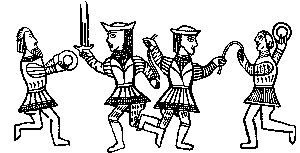
The short cape, with or without a hood, was called: cocholl corresponding in shape and name with the Gallo-Roman cucullus, English cowl: but this English word cowl is now often applied to a hood simply. This fashion continued long: Thomas Dineley (in 1675) observed that the men, in parts of Ireland, covered their heads with their cloaks.
The Gaelic form of this name is celt [kelt], of which "kilt" is a phonetic rendering. The word occurs so seldom, and is used so vaguely, that we might find it difficult to identify the particular article it designates, if the Scotch had not retained both the article itself and its name: for the Highland kilt is the ancient Irish celt. The kilt - commonly falling to the knees - is very frequently met with on the figures of manuscripts, shrines, and crosses, so that it must have been very much worn both by ecclesiastics and laymen. It appears in a very decided form in the eleventh-century illustration given here (fig. 120).
Kass McGann takes issue with the idea of an Irish Kilt. (See below.) I think that most Irish people would agree with Kass.
I've put the commentary 'in-line' rather than as a separate page. The ancients didn't have that luxury.

P.W. Joyce's analysis of ancient Irish dress is deeply flawed in its
identification of an Irish kilt. In passages from these books, O'Curry translated the word "leine" ("leinidh," "lene," etc.) alternately as "shirt" and "kilt." Through his own explanation, when the ancient manuscripts mentioned a garment of fine linen "placed upon his white skin," he translated it "shirt." When the tracts mentioned a boarder of silk or embroidery descending to the knees, he translated it as "kilt." In the Old Irish, the spellings of both words were often the same. O'Curry points to one passage in particular to prove that the "leine" was a kilt. This passage, on page 143 of the third volume, is from a poem in the Leabhar na h-Uidhre. It describes the monarch Conaire Mor, the epitome of the illustrious chieftain: I saw his splendid linen kilt, O'Curry's footnote 201 reads, "This passage clearly proves that the Leinidh was a kilt or petticoat reaching to the knees. See on this subject Lect. XXIII., ante, vol. ii. p. 106." Firstly, O'Curry is breaking his own definition of "Leinidh" by calling a linen garment a "kilt." Then he seems to assume that everything that reaches to the knees is a kilt. Why couldn't a "shirt" reach to the knees? Thirdly, the passage mentions a number of features of this "kilt" that describe portions above the waist. The "striped silken boarders" are referred to as "a face reflecting mirror." The only way this would be possible is if those boarders were around the neck of the garment. The boarders are also described as "embracing his noble neck." Another piece of evidence that the "Leinidh" began at the neck. The last couplet clinches the proof. "An embroidery of gold upon the lustrous silk from his bosom to his noble knees." Unless the waistband of this kilt was worn very high, the embroidery couldn't extend "from his bosom." What we have here is the description of a highly ornamented, knee-length tunic. This jives etymologically with the modern Irish translation of the word "leine" (the modernized spelling of "leinidh") as "shirt." However, we should not jump to conclusions that O'Curry was wrong in his description of the leine. It has been suggested by researchers since O'Curry's time that his classification of the leine as a "kilt" was not wrong, but our reading of what he meant by "kilt" is. W. K. Sullivan, Ph.D., Secretary of the Royal Irish Academy and writer of the thousand-page introduction to O'Curry's work, gives this perspective: "O'Curry concluded that the Lena was a kilt. From such brief descriptions of it as are available, it appears to have been a tight-fitting garment apparently without sleeves, which covered the upper part of the body and extended to the knees." -- pg ccclxxviii of Vol. 1 It is clear by this passage that O'Curry and Sullivan did not mean what we think of when we hear the word "kilt," but rather a garment with skirts, i.e. a long tunic. Henry Foster McClintock, in his 1947 work "Old Irish and Highland Dress" made this same analysis. He says, "I think it is clear that, so far as the evidence adduced goes, the word [Leinidh] cannot be properly translated as "kilt"." As to Joyce's statement that "the Gaelic form of this name is celt, of which kilt is a phonetic rendering," this cannot be substantiated. "Kilt" is an English word of Scandinavian origin (ME kilten "to tuck up" of Scand. orig. -- Webster's New College Dictionary, 1995) and not Gaelic at all. The Gaelic word for kilt is "filleadh" (FIL-ah) meaning folded and used in the Scottish "filleadh beag" (filabeg) meaning little kilt, and "filleadh mor" (filamore) meaning great kilt or belted plaid. Regarding the reference to the eleventh-century illustration (figure 120), this is drawn after the bronze figures on the side of the Shire of St. Manchan in Offaly. George Petrie described them as being dressed in a kilt and wearing mantle fastened on the breast by a brooch. Rev. James Graves thought they wore a close fitting garment with a sleeved jacket over it. When one looks at the figures, they appear naked to the waist at first glance (their ribs are clearly showing and there are marks indicating their abdominal muscles). Yet marks indicating sleeves and necklines are also clear. McClintock takes up this view and points out that what Petrie took for brooches are merely the rivets by which the figures are attached to the shrine. From studying photographs of the original and reading the descriptions of ancient dress, conclusions can be drawn regarding Irish dress. The garments are not "shirt and skirt" combinations of any form but rather one body-covering garment. The figures appear to be wearing leinte with elaborately embroidered lower boarders like Conaire Mor's leine described above. In this case, the embroidery extends from the hips to the knees, not from the bosom. The lines described as "abdominal muscles" look more like folds in the fabric as it rests on the hips. Any close-fitted, drop-waisted dress will do the same. The arms appear to be wearing tight sleeves yet the marks described as "ribs" look like the bagpipe sleeves of the later (16th century) incarnations of the leine (the saffron shirt of the Irish kern). If this is true, the figures may be wearing a tight jacket as Graves described. The 16th century version of the ionar (jacket) had tight sleeves that opened along their bottom seam. This was to accommodate the large, bagpipe sleeves of the leine of that day. Is this what we are seeing here? Could this be a prototype of what was to be worn in a later century? This, of course, is purely conjecture based upon the personal opinion of this author. T. D. Kendrick and Elizabeth Senior expressed another opinion in their 1935 article in the Illustrated London News: "[The figures in question] are thought to be crude derivations from the continental type of Crucifix figure. They were probably made at a later date in the twelfth century than the shrine... The importance of these figures in the history of Irish art is considerable, for they announce the intrusion of a foreign style in the twelfth century that is in fact the beginning of a noticeable decline." McClintock concludes from this that the figures therefore have no bearing on Irish costume at all. These are the kinds of things in Irish costuming history that we might never definitively know. Kass McGann |
The over-garments were fastened by brooches, pins, buttons, girdles,
strings, and loops. Brooches will be treated of in next section.
Simple pins were generally ornamented, head, or shank, or both,
as seen in the figures below, of which the originals
are all in the National Museum, with many others.
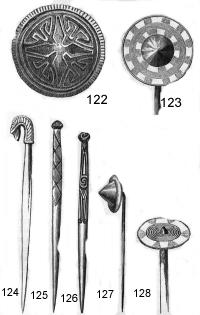
The ancient Irish wore a trousers which differed in some respects
from that worn at the present day. It generally reached from the
hips to the ankles, and was so tight-fitting as to show perfectly
the shape of the limbs. When terminating at the ankles it was
held down by a slender strap passing under the foot, as seen
in one of the figures in the Book of Kells. Like other Irish garments
it was generally striped or speckled in various colours.
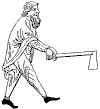
Leggings (called ochra) of cloth or of thin soft leather were worn, probably as an accompaniment to the kilt. They were laced on by strings tipped with findruine or white bronze, the bright metallic extremities falling down after lacing, so as to form pendant ornaments. There are many passages in our ancient literature showing that it was pretty usual with those engaged in war to leave the legs naked : a fashion perpetuated by the Scotch to this day. This fashion is also indicated by such nicknames as Glu/nduff ('black knee'), Glu/ngel (white knee'), &c., which were very common.
As illustrative of all that precedes, a series of costumes of
the year 1600 are presented here.

(From Speed's map of Ireland : AD 1611)
Both men and women wore a garment of fine texture next the skin. This is constantly mentioned in the tales, and, whether for men or women, is denoted by the word léine or léne [2.syll], which is now the common Irish word for a shirt. It was usually made of wool or flax: some-times it was of silk, occasionally of satin, highly ornamented with devices in gold and silver thread, worked with the needle
A girdle or belt (Ir. Criss) was commonly worn round the waist, inside the outer loose mantle; and it was often made in such a way as to serve as a pocket for carrying small articles. Sometimes a bossa n or purse (also called sparan) was hung from it, in which small articles were kept, such as rings. The girdles of chiefs and other high-class people were often elaborately ornamented and very valuable: worth from £40 to £100 of our money ( note - written in 1908). Garters were worn, sometimes for use and sometimes for mere ornament, or to serve both purposes. They were made of various materials according to the rank of the wearer: kings, chiefs, and ollaves of poetry often wore garters of gold.
That gloves were commonly worn is proved by many ancient passages and indirect references. They appear to have been common among all classes - poor as well as rich. One of the good works of charity laid down in the Senchus M6r is "sheltering the miserable," which the gloss explains, "to give them staves and gloves and shoes for God's sake." The evangelist depicted in the Book of Kells (fig. 118, p.387, above) wears gloves, with the fingers divided as in our present gloves, and having the tops lengthened out beyond the natural fingers. Rich people's gloves were often highly ornamented. As to material: probably gloves were made, as at present, both of cloth and of animal skins and furs. The importance and general use of gloves as an article of dress are to some extent indicated by their frequent mention and by the number of names for them. The common word for a glove was lamann, which is still in use.
The men wore a hat of a conical shape, without a leaf, called a barréd [barraid], a native word, of which the first syllable, barr, signifies top. Among the peasantry, the men, in their daily life, commonly went bare-headed, wearing the hair long behind so as to hang down on the back, and clipped short in front. Sometimes men, even in military service, when not engaged in actual warfare, went bare-headed in this manner. In the panels of one of the crosses at Clonmacnoise are figures of several soldiers: and while some have conical caps, others are bare-headed. Camden describes Shane O'Neill's galloglasses, as they appeared at the English court in the sixteenth century, as having their heads bare, their long hair curling down on the shoulders and clipped short in front just above the eyes.
Married women usually had the head covered either with a hood (caille, pron. cal-le) or with a long web of linen wreathed round the head in several folds. The veil was in constant use among the higher classes, and when not actually worn was usually carried, among other small articles, in a lady's ornamental hand-bag.
The most general term for a shoe was bróg, which was applied
to a shoe of any kind: it is still the word in common use. The
bróg was very often made of untanned hide, or only half
tanned, free from hair, and retaining softness and pliability
like the raw hide. This sort of shoe was also often called cuarán
or cuaróg, from which a brogue-maker was called cuaránaidhe
[cooraunee]. This shoe had no lift under the heel: the whole
was stitched together with thongs cut from the same hide. But
there was a more shapely shoe than the cuarán, made of
fully tanned leather, having serviceable sole and heel, and often
highly ornamented. There are several specimens of such shoes
in the National Museum, Dublin, of which one is represented here.
(fig. 136). 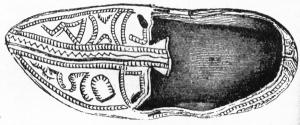
To this kind of shoe the two terms ass (pl.
assa) and maelan were often applied; but these have
long dropped out of use. Most of the figures depicted in the Book
of Kells and on the shrines and high crosses have shoes or sandals,
though some have the feet bare. One wears well-shaped narrow-toed
shoes seamed down along the instep, something like the shoe represented
on last page (fig. 136), but much finer and more shapely. Some
have sandals consisting merely of a sole bound on by straps running
over the foot: and in all such cases the naked toes are seen.
On many of the sandals there are what appear to be little circular
rosettes just under or on the ankles, one on each side of the
foot perhaps mere ornaments. They are seen in fig. 137 given
here, also from the Book of Kells.

In many of the most ancient Irish tales we often find it mentioned
that persons wore assa or maelassa or shoes made
of silver or of findruine (white bronze). Such shoes or
sandals must have been worn only on special or formal occasions:
as they would be so inconvenient as to be practically useless
in real everyday life. As confirming this idea of temporary and
exceptional use, we have in the National Museum a curious pair
of (ordinary leather) shoes-shown in the illustration - connected
permanently, so that they could only be used by a person sitting
down or standing in one spot.
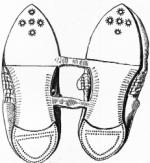
In whatever way and for whatever purpose the metallic shoes were used, they must have been pretty common for many have been found in the earth, and some are now preserved in museums. There were tradesmen, too, who made and dealt in them, as is proved by the fact that about the year 1850 more than two dozen ancient bronze shoes were found embedded in the earth in a single hoard near the Giant's Causeway.
The finding of bronze shoes, and in such numbers, is a striking illustration of how the truthfulness of many old Irish records, that might otherwise be considered fabulous, is confirmed by actual existing remains.